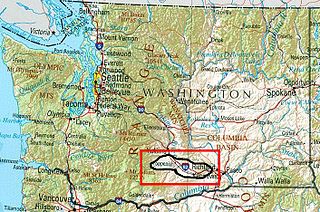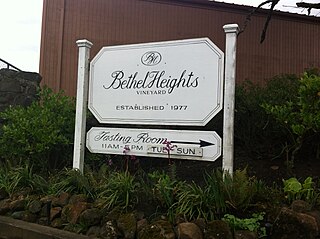Related Research Articles

New Zealand wine is produced in several of its distinct winegrowing regions. As an island country in the South Pacific Ocean, New Zealand has a largely maritime climate, although its elongated geography produces considerable regional variation from north to south. Like many other New World wines, New Zealand wine is usually produced and labelled as single varietal wines, or if blended, winemakers list the varietal components on the label. New Zealand is best known for its Marlborough Sauvignon Blanc, and more recently its dense, concentrated Pinot Noir from Marlborough, Martinborough and Central Otago.

Brown Brothers Milawa Vineyard is a family-owned wine company based in Milawa, Victoria, Australia. Brown Brothers was founded in 1889 by John Francis Brown and continues to be owned and operated by his descendants on the original property. Brown Brothers makes wine from a wide range of grape varieties and into a range of styles.

Washington wine is a wine produced from grape varieties grown in the U.S. state of Washington. Washington ranks second in the United States in the production of wine. By 2017, the state had over 55,000 acres (220 km2) of vineyards, a harvest of 229,000 short tons (208,000 t) of grapes, and exports going to over 40 countries around the world from the 940+ wineries located in the state. While there are some viticultural activities in the cooler, wetter western half of the state, the majority (99.9%) of wine grape production takes place in the shrub-steppe eastern half. The rain shadow of the Cascade Range leaves the Columbia River Basin with around 8 inches (200 mm) of annual rain fall, making irrigation and water rights of paramount interest to the Washington wine industry. Viticulture in the state is also influenced by long sunlight hours and consistent temperatures.
The state of Oregon in the United States has established an international reputation for its production of wine, ranking fourth in the country behind California, Washington, and New York. Oregon has several different growing regions within the state's borders that are well-suited to the cultivation of grapes; additional regions straddle the border between Oregon and the states of Washington and Idaho. Wine making dates back to pioneer times in the 1840s, with commercial production beginning in the 1960s.

Yakima Valley is the first American Viticultural Area (AVA) established within Washington state, gaining the recognition on May 4, 1983. Within the vast Columbia Valley AVA, Yakima Valley appellation cultivates more than 53,000 acres (21,448 ha) giving the region the largest concentration of wineries and vineyards in the state. The most widely planted varietals in the area are Chardonnay, Riesling, Merlot, Cabernet Sauvignon, Pinot gris, and Syrah. Nearly 40% of Washington's annual wine production is made from Yakima Valley grapes. In addition to grapes, the Yakima Valley is also home to several fruit orchards growing apples, cherries, nectarines, peaches, pears and plums. Around the town of Zillah, there is the Zillah Fruit Loop driving tour through the area's orchards and vineyards. The area is also home to nearly 80% of the US hop production. In July 2024, the Yakima Valley was named best wine region in the U.S. by readers of USA Today.

Willamette Valley Vineyards is an American winery located in Turner, Oregon. Named after Oregon's Willamette Valley, the winery is the leading producer of Willamette Valley-appellated Pinot Noir in Oregon, and also produces Chardonnay and Pinot Gris. In 2016, the winery was the largest producer of Riesling wine in the Willamette Valley.

Moselle wine is produced in three countries along the river Moselle: France, Luxembourg and Germany. Moselle wines are mainly white and are made in some of the coldest climates used for commercial winemaking.

Bridgeview Vineyard and Winery is one of the largest wineries in Oregon. Located in Cave Junction, Oregon, Bridgeview is noted for its chardonnay, pinot gris, and pinot noir. Its 85-acre (340,000 m2) estate in the Illinois Valley is planted in the European style of dense six-foot row and four-foot vine spacing. Bridgeview also has an 80-acre (320,000 m2) vineyard in the Applegate Valley.

California wine production has a rich viticulture history since 1680 when Spanish Jesuit missionaries planted Vitis vinifera vines native to the Mediterranean region in their established missions to produce wine for religious services. In the 1770s, Spanish missionaries continued the practice under the direction of the Father Junípero Serra who planted California's first vineyard at Mission San Juan Capistrano.

Victorian wine is wine made in the Australian state of Victoria. With over 600 wineries, Victoria has more wine producers than any other Australian wine-producing state but ranks third in overall wine production due to the lack of a mass bulk wine-producing area like South Australia's Riverland and New South Wales's Riverina. Viticulture has existed in Victoria since the 19th century and experienced a high point in the 1890s when the region produced more than half of all wine produced in Australia. The phylloxera epidemic that soon followed took a hard toll on the Victoria wine industry which did not fully recover till the 1950s.
Valley View Winery is a winery in the Applegate Valley AVA in Southern Oregon, United States, founded in 1972.

The Old Mission Peninsula AVA is an American Viticultural Area located in Grand Traverse County, Michigan known for well-regarded Michigan wine. The Old Mission Peninsula extends northward from Traverse City into the Grand Traverse Bay of Lake Michigan, ending at Old Mission Point. The peninsula is 19 miles (31 km) long by 3 miles (5 km) wide at its widest point. The climate on the peninsula is moderated by the surrounding waters, helping to prevent frost during the growing season. Grape varietals suitable to cool climates, such as Riesling, Chardonnay, Gewürztraminer, Pinot gris, Pinot noir, Cabernet Franc, and Merlot do best in the Old Mission Peninsula AVA.

British Columbia wine is Canadian wine produced in the province of British Columbia. Wines made from 100% British Columbia grapes can qualify for classification under one of British Columbia's two classification systems, depending on the variety, the winemaking techniques employed, and various other restrictions.

Reif Estate Winery is located in Niagara-on-the-Lake in Ontario, Canada. Reif Estate is primarily known for playing an important in role pioneering the Ontario wine Industry, as well as planting some of the first Vitis vinifera vines in the Niagara region.

An international variety is a grape variety that is widely planted in most of the major wine producing regions and has widespread appeal and consumer recognition. These are grapes that are highly likely to appear on wine labels as varietal wines and are often considered benchmarks for emerging wine industries. There is some criticism that the popularity of so-called international varieties comes at the price of a region's indigenous varieties. The majority of declared international varieties are French in origin, though in recent years the popularity of Spanish and Italian varietals has seen an increase in worldwide plantings and these may also be considered "international varieties".
Cono Sur Vineyards & Winery is a subsidiary of Concha y Toro Winery and is the third largest exporter of bottled wine in Chile. Established in 1993, its name is a reference to its location in the Southern Cone of South America and a play on the word connoisseur. In 2015, it was the official wine of the Tour de France.

Trisaetum is a winery located in Oregon's Willamette Valley. Established in 2003 by Andrea and James Frey, the winery, pronounced "tris-say-tum", was named after the founders two children, Tristen and Tatum. The winery is still family owned and operated and produces small lots of critically acclaimed Pinot Noir and Riesling from its estate vineyards. Trisaetum's older vineyard, the Coast Range estate, is a 22-acre (89,000 m2) vineyard located in the southwestern corner of the Yamhill-Carlton District AVA. Trisaetum's winery is located on its newer 17-acre (69,000 m2) vineyard in the heart of the Ribbon Ridge AVA.

Cecil O. De Loach Jr. is a California grape-grower and winemaker in the Russian River Valley AVA who has contributed to the reputation and notoriety of Sonoma County viticulture.

Bethel Heights Vineyard is an Oregon winery in the Eola-Amity Hills AVA of the Willamette Valley. Founded in 1977 by twin brothers Ted and Terry Casteel, their wives Pat Dudley and Marilyn Webb, and Pat's sister Barbara Dudley, the vineyard was one of the earliest plantings in the Eola-Amity Hills region. A winery soon followed, with the first estate wines produced in 1984. Bethel Heights specializes in Pinot noir, offering several individual block and vineyard designated bottlings, but also produces wines made from Chardonnay, Pinot gris, Pinot blanc, Riesling, Grüner Veltliner, and Gewürztraminer.

Sokol Blosser Winery is a historic vineyard, tasting room and winery facility located northeast of Dayton, Oregon in the Red Hills of Dundee in Yamhill County. It was founded by Bill Blosser and Susan Sokol Blosser in 1971 in what is now known as the Dundee Hills AVA. Sokol Blosser Winery is family owned and operated by second-generation President Alex Sokol Blosser, and is the 6th largest wine producer in Oregon. Sokol Blosser is considered to be “synonymous with sustainability,” and produces Pinot Noir, Pinot Gris, Chardonnay, Sauvignon Blanc, Müller-Thurgau, Pinot Blanc, and proprietary blends Evolution White, Red, Pinot Noir, Sauvignon Blanc and Riesling and a range of other Evolution wines, and small quantities of single block Pinot Noirs, Rosé of Pinot Noir, White Riesling dessert wine, and sparkling wine. In 2023 the Winery introduced red and white Aperitif Wines, produced from a blend of alcohol distilled from their grapes and a blend of herbs.
References
- ↑ Goracke, Susan (January 24, 2008). "Ted and Terri Gerber finish Foris Vineyards buy out". Mail Tribune, Retrieved January 27, 2014
- ↑ Klooster, Carl (2008-12) "The Big Boys Down South". Oregon Wine Press (Not available to retrieve.)
- ↑ Howie, Millie 2000-September/October. Foris Winery, "Winegrowers' Association Honors Trailblazing Oregon Couple". Practical Winery Magazine (Not available to retrieve)
- ↑ Gregutt, Paul. (April 2, 2011) "Wines in spotlight euro-gon", Paul Gregutt blog
- ↑ Twitchell, Cleve (November 28, 2007). "Foris offers bargains for wine lovers". Medford Mail Tribune
- ↑ Foris Vineyards Winery, "Great Awakenings: An Eclectic History of Foris Winery". Accessed January 27, 2014
- ↑ Kent, Roberta (January 15, 2014) "Homework has paid off for Foris wines." Mail Tribune
- ↑ Twitchell, Cleve (November 28, 2007). "Foris offers bargains for wine lovers". Medford Mail Tribune . Archived from the original on June 10, 2011. Retrieved December 3, 2007.
- 1 2 Foris Vineyards Winery "The Vineyards"
- ↑ Pawsey, Tim (September/October 2000) "The Jefferson State of Wine" Northwest Palate
- ↑ Eastman, Janet "Oregon Wine, Japanese Clients......When Opportunity Knocked, Foris Vineyards Answered", Mail Tribune
- ↑ Rutan, Roger (May 3, 2006). "Oregon wine pioneer made the right call in Illinois Valley". The Register-Guard . Retrieved December 4, 2007.[ permanent dead link ]
- ↑ "Local Business". Medford Mail Tribune. January 24, 2008. Retrieved January 24, 2008.